Discover the vibrant heart of Bhutan with our guide to the Top 10 Places to Visit in Punakha. This historic district, once the capital of Bhutan, is renowned for its magnificent Punakha Dzong and the stunning Punakha Suspension Bridge. Explore the spiritual serenity at the Khamsum Yulley Namgyal Chorten and seek blessings at the unique Chimi Lhakhang fertility temple. Adventure seekers can enjoy thrilling Mo Chhu river rafting, while those seeking peace can visit the tranquil Sangchhen Dorji Lhuendrup Nunnery. Engage with history and culture at the Nalanda Buddhist Institute, or experience traditional life in Ritsha Village. Punakha offers a blend of spiritual, cultural, and adventurous experiences, making it a must-visit destination for every traveler.
At Druk Holidays, we pride ourselves on being the premier choice for discovering the Top 10 Places to Visit in Punakha. Our expertly curated tours encompass everything from the majestic Punakha Dzong, a testament to Bhutanese heritage, to the thrilling Mo Chhu river rafting adventures. With Druk Holidays, you're not just visiting; you're immersing yourself in the rich tapestry of Punakha's cultural landmarks, spiritual sanctuaries like the Chimi Lhakhang fertility temple, and breathtaking natural scenery. Whether you're exploring the historical depths of Nalanda Buddhist Institute or seeking the tranquility of the Sangchhen Dorji Lhuendrup Nunnery, our tailored experiences ensure that every traveler finds a piece of Punakha that resonates deeply with their spirit. Join us to explore the best that Punakha has to offer, with the comfort and expertise that only Druk Holidays can provide.
Punakha Dzong
Punakha Dzong, also known as the 'Palace of Great Happiness', stands majestically at the confluence of the Pho and Mo Chhu rivers, serving as a symbol of unity and harmony in Bhutan. Built-in 1637 by Zhabdrung Ngawang Namgyal, this fortress is one of the oldest and most spectacular dzongs in Bhutan, showcasing a remarkable blend of architectural prowess and historical significance. It continues to be a focal point of religious and ceremonial importance in Bhutanese culture.
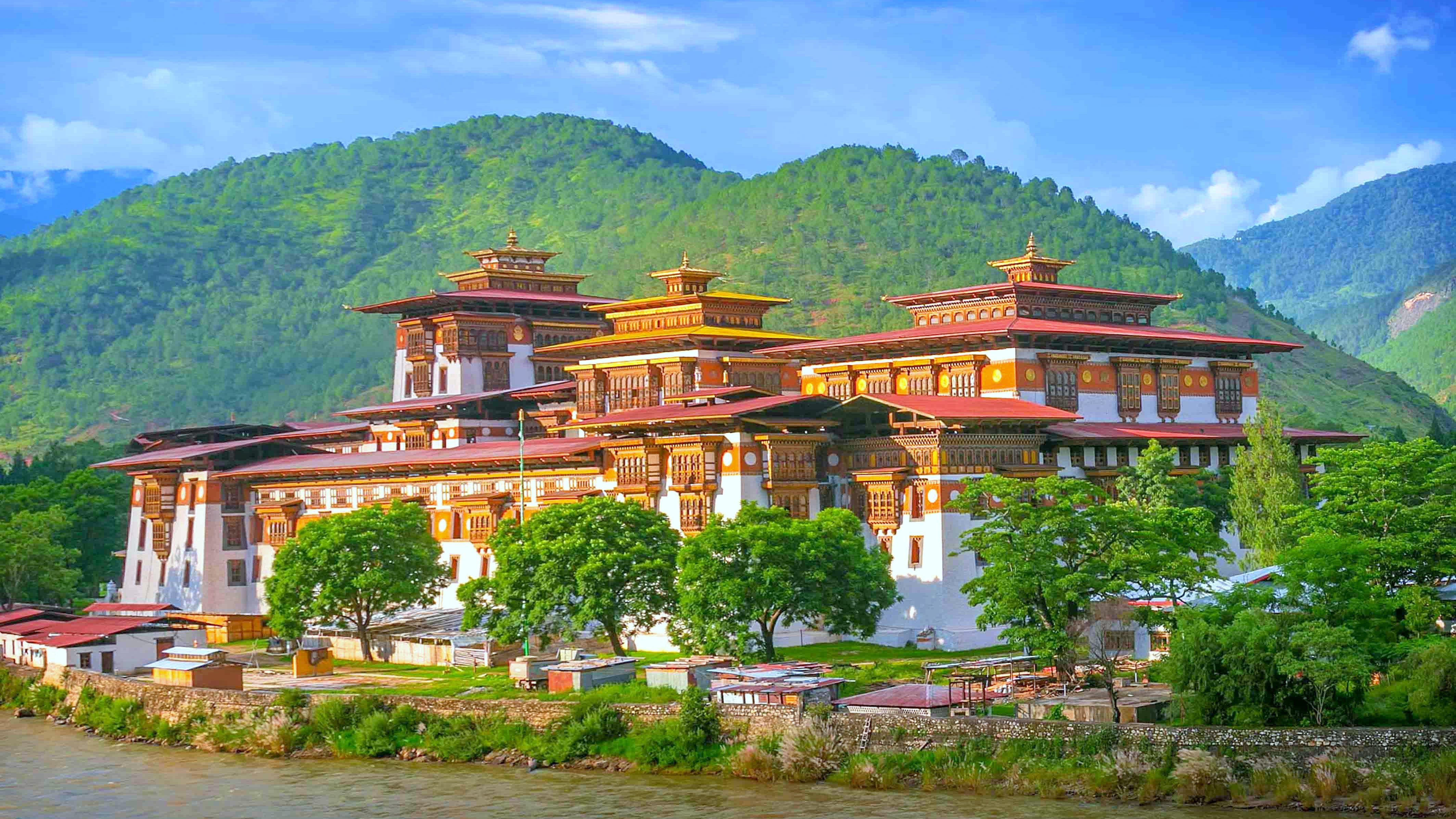
- Architectural Grandeur: The dzong’s impressive structure features intricate woodwork and a series of courtyards and temples, adorned with beautiful Bhutanese Buddhist art.
- Strategic Location: Located at the confluence of two rivers, the dzong offers stunning views and strategic advantage, historically protecting the town from invasions.
- Mo Chhu and Pho Chhu Rivers: The rivers that border the dzong add to the scenic beauty of the area, creating a peaceful ambiance that complements the spiritual atmosphere.
- Jacaranda Trees: During the spring, the dzong is surrounded by blooming jacaranda trees, which cover the area in a vibrant purple hue, adding a surreal beauty to the fortress.
- Kuenrey (Assembly Hall): The main assembly hall is a significant area within the dzong where monks gather for daily prayers and ceremonies, richly decorated with religious paintings and statues.
- Coronation Site: It is the traditional site of the coronation of Bhutan’s kings and continues to host significant national events, including the annual Punakha Drubchen and Tshechu festivals.
- Historic Chapels: Within its walls, the dzong houses several chapels, including the Machen Lhakhang, which contains the preserved remains of Zhabdrung Ngawang Namgyal.
- Dzong’s Bridge: The traditional cantilever bridge leading to the dzong is an iconic feature, offering picturesque views and a historical route for those entering the fortress.
Punakha Dzong is not just an architectural marvel but also a living museum that offers insight into Bhutan's rich history and spiritual depth. Visiting the dzong provides a unique opportunity to step back in time and experience the cultural heritage that is meticulously preserved within its walls. Whether you're a history buff, architecture enthusiast, or spiritual seeker, Punakha Dzong stands as a testament to the artistry and ethos of Bhutan, making it a must-visit landmark in the heart of the Himalayas.
Punakha Suspension Bridge
The Punakha Suspension Bridge is not just a practical crossing over the Mo Chhu River; it is one of Bhutan’s most picturesque and exhilarating attractions. This bridge, one of the longest of its kind in Bhutan, connects the nearby Punakha Dzong to the rest of the valley, offering breathtaking views and a thrilling experience as it sways gently above the river. Its vibrant prayer flags flutter in the wind, adding a colorful and spiritual dimension to the bridge, symbolizing the local culture and religious devotion.
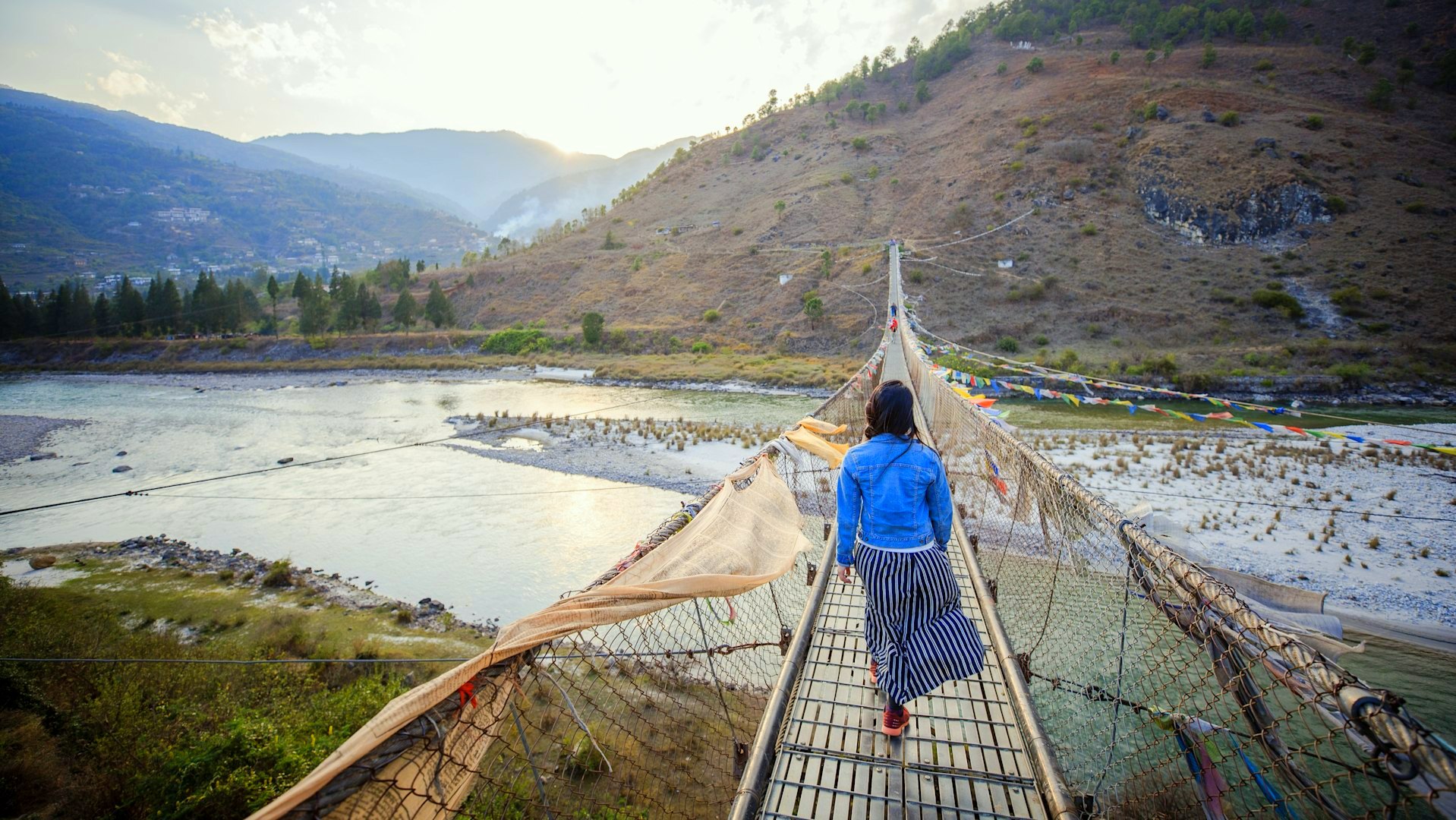
- Impressive Length: Stretching over 160 meters, this is one of the longest suspension bridges in the country, providing a scenic passage across the Mo Chhu river.
- Scenic Views: The bridge offers panoramic views of the Punakha Valley, including the dzong, river, and surrounding lush landscapes, making it a photographer’s paradise.
- Prayer Flags: Adorned with countless multicolored prayer flags, the bridge presents a vivid display of Bhutanese spiritual culture. These flags are believed to spread peace and good will with the wind.
- Engineering Marvel: The structure showcases traditional Bhutanese bridge construction techniques, combining functionality with aesthetic appeal.
- Cultural Significance: It serves as a vital link during local festivals, especially during the Punakha Tshechu, when locals cross it to attend events at the dzong.
- Accessibility: The bridge is accessible to both pedestrians and cyclists, making it a convenient and exciting passage for visitors exploring the region.
- Atmospheric Experience: Walking across the bridge can be a thrilling experience as it sways slightly with each step, especially with the rushing waters of the Mo Chhu below.
- Bird Watching: The surrounding area is a habitat for various bird species, offering opportunities for bird watching, particularly in the early mornings and late afternoons.
The Punakha Suspension Bridge is much more than a crossing—it is a destination in its own right, offering a unique perspective of the Punakha Valley’s natural beauty and cultural vibrancy. Whether you're visiting for the stunning views, to participate in a festival, or simply to experience the thrill of crossing this hanging bridge, it promises a memorable part of any visit to Punakha. This iconic structure not only connects lands but also connects visitors with the rich traditions and serene landscapes of Bhutan.
Khamsum Yulley Namgyal Chorten
The Khamsum Yulley Namgyal Chorten stands as a testament to peace, harmony, and royal dedication in Bhutan. This stunning stupa, built on a picturesque hill overlooking the Punakha Valley, was commissioned by the Queen Mother to ward off negative energies and promote peace, stability, and harmony across the world. Unlike many ancient temples, this chorten was completed in 2004, making it a relatively new addition to Bhutan’s spiritual landscape, yet it follows the sacred traditions and architectural norms of Bhutanese zangdogpelri (celestial abode of Guru Rinpoche).
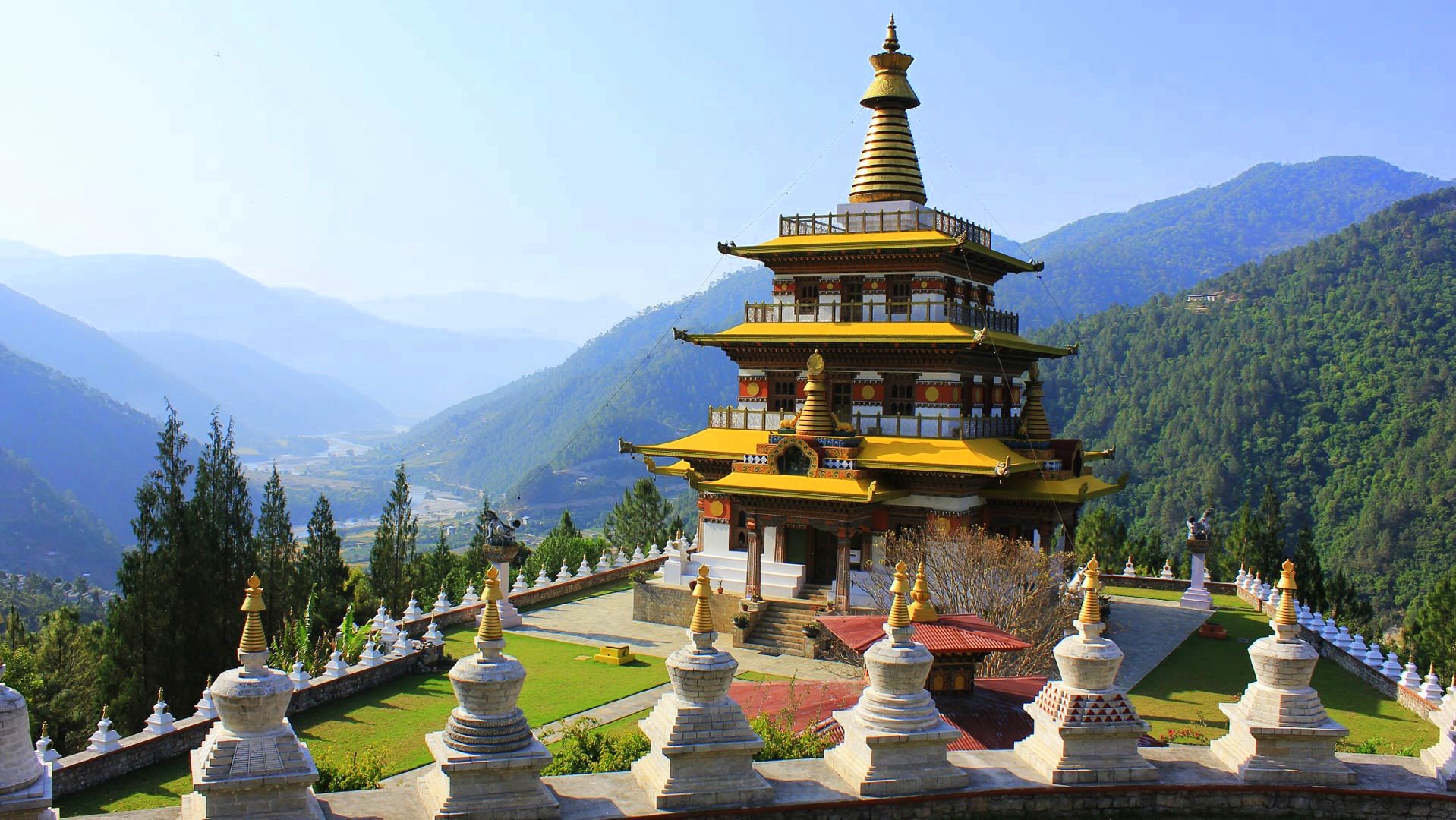
- Unique Architecture: The chorten is a fine example of Bhutanese architectural ingenuity, featuring elaborate carvings, vibrant colors, and traditional designs that promote spiritual and artistic ethos.
- Spiritual Significance: Designed to bring peace to the world, the chorten contains sacred relics and offers spaces for meditation and prayer, contributing to its serene atmosphere.
- Panoramic Views: Situated on a hill, visitors are treated to sweeping views of the lush Punakha Valley, the meandering rivers, and the surrounding Himalayan landscape.
- Artistic Murals: Inside, the walls are adorned with beautifully detailed murals and frescoes depicting religious figures and spiritual motifs, which are significant in Vajrayana Buddhism.
- Peaceful Hike: The journey to the chorten is a peaceful hike through rice fields and up the hill, providing a tranquil experience amidst nature.
- Cultural Insight: The structure stands as a symbol of the Bhutanese people’s dedication to spiritual and worldly peace, reflecting the kingdom's deep-rooted Buddhist philosophy.
- Photographic Spot: Its distinctive appearance and scenic backdrop make it a favorite spot for photographers looking to capture the essence of Bhutan’s spiritual and natural beauty.
- Community Involvement: The chorten was built with local labor and is maintained by the community, reflecting the communal spirit prevalent in rural Bhutan.
Visiting the Khamsum Yulley Namgyal Chorten is not just about witnessing a beautiful monument; it's about experiencing the peace and spiritual depth it was built to cultivate. It represents a harmonious blend of human effort and spiritual ideals, standing not only as a structure but as a beacon of peace and stability. Whether you come here for spiritual solace, to admire the art, or simply to enjoy the views, the chorten offers a profound and enriching experience in the heart of Punakha.
Chimi Lhakhang
Nestled in the fertile Punakha valley, Chimi Lhakhang, famously known as the Fertility Temple, is a unique symbol of Bhutanese culture. Dedicated to Lama Drukpa Kunley, also revered as the 'Divine Madman' for his unconventional approach to Buddhism, this temple attracts not only the faithful but also couples from around the world seeking blessings for fertility. Built in 1499, this quaint temple is as much a pilgrimage site as it is a testament to Bhutanese whimsy and spiritual beliefs.
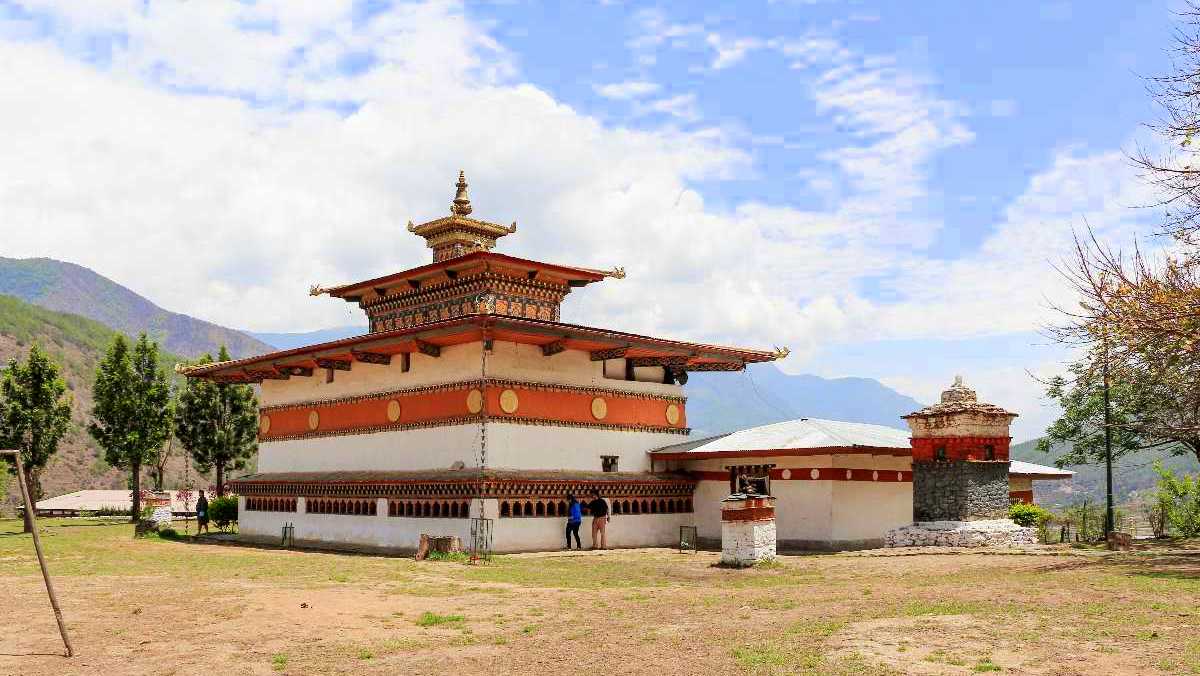
- Spiritual Legacy: The temple honors the maverick saint, Lama Drukpa Kunley, who taught through songs, humor, and outrageous behavior, challenging the rigid orthodoxies of his time.
- Symbol of Fertility: Couples who have difficulty conceiving come to pray for children, often leaving behind symbols of fertility or carrying a wooden phallus, a cultural emblem associated with the Lama.
- Scenic Location: Surrounded by the verdant fields of the Punakha Valley, the temple offers a tranquil retreat and picturesque landscapes, making the journey a serene experience.
- Architectural Charm: The temple's modest structure is adorned with colorful and intricate paintings that illustrate the life of Drukpa Kunley, blending spiritual depth with artistic heritage.
- Cultural Experience: Visitors often receive a blessing involving a phallus totem, wielded by the resident monk, which is believed to encourage fertility and ward off evil spirits.
- Lively Festivals: The temple becomes a vibrant hub during local festivals, where the life and teachings of Drukpa Kunley are celebrated with great enthusiasm and joy.
- Family Blessings: Families who received their wish for a child often return to name their newborns in a special ceremony held at the temple, deepening their spiritual connection to this site.
- Visitor Accessibility: Unlike many religious sites, Chimi Lhakhang has an open and welcoming atmosphere, inviting tourists to participate in its traditions and learn about Bhutanese spirituality firsthand.
Chimi Lhakhang stands out not just as a religious site but as a cultural icon that embodies the playful spirit and deep faith of the Bhutanese people. Whether you are seeking blessings, interested in unique cultural practices, or simply want to enjoy the beauty and tranquility of the Punakha Valley, Chimi Lhakhang offers a memorable and enriching experience for all who visit.
Talo Monastery
Perched high above the verdant valleys of Punakha, Talo Monastery offers a serene escape into spiritual solitude and architectural beauty. This monastery is not only a place of worship but also a testament to the rich monastic tradition of Bhutan. It serves as the seat of the Talo Sangngak Choling and is renowned for its scenic location, which provides breathtaking views of the surrounding landscapes and the pristine serenity of the region.
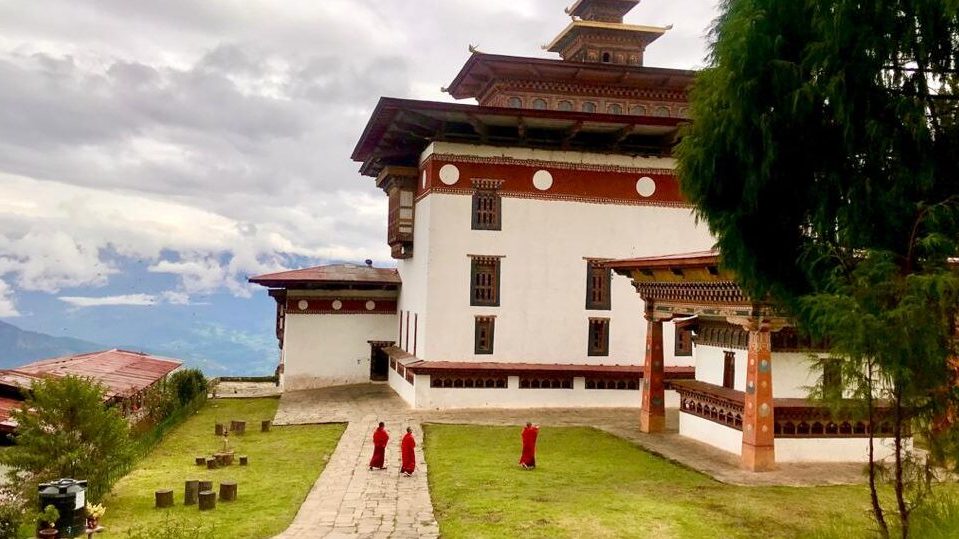
- Stunning Location: Situated atop a hill, Talo Monastery overlooks the lush Punakha valley, offering panoramic vistas that captivate visitors and provide a tranquil environment for meditation and reflection.
- Architectural Elegance: Known for its cleanliness and the ornate detail of its buildings, Talo Monastery features traditional Bhutanese architecture with intricately painted woodwork and beautifully adorned prayer halls.
- Spiritual Center: As a religious hub, it plays a crucial role in the spiritual life of the community, hosting regular religious ceremonies and serving as a retreat for monks who seek solitude and spiritual growth.
- Historical Significance: The monastery is the ancestral home of the Royal Queen Mothers of Bhutan, adding a layer of historical and cultural significance to its spiritual functions.
- Gardens and Surroundings: The well-maintained gardens and the peaceful ambiance of the monastery grounds offer a perfect setting for visitors to explore or sit quietly and absorb the tranquil atmosphere.
- Artistic Frescoes: Inside, visitors can admire the exquisite frescoes and statues that depict various aspects of Buddhist lore and the life of Buddha, enriching their understanding of Bhutanese religious art.
- Festive Celebrations: Talo Monastery is famous for its annual religious festival, which features masked dances and cultural performances that draw both locals and tourists, highlighting Bhutanese traditions and religious practices.
- Community Engagement: The monastery is an integral part of the local community, providing religious guidance, education to young monks, and participating in communal activities, which reflects the symbiotic relationship between the monastery and the inhabitants of Talo village.
Talo Monastery is more than just a religious site; it is a beacon of peace and tradition in Bhutan. Its picturesque setting, rich history, and vibrant cultural life make it a must-visit for anyone traveling to Punakha. Whether you are drawn by the pursuit of spiritual insight, interested in Bhutanese architecture, or simply in search of peace, Talo Monastery offers a profound and enriching experience.
Limbukha Village
Nestled amidst the serene landscapes of Punakha, Limbukha Village is renowned for its peaceful atmosphere and the unique cultural heritage of its inhabitants. Known as the 'village of peace,' Limbukha is distinguished by its commitment to non-violence and its traditional agricultural practices, particularly the cultivation of Bhutan's famous red rice. This tranquil village offers visitors a glimpse into the rural lifestyle of Bhutan, steeped in harmony and historical traditions.
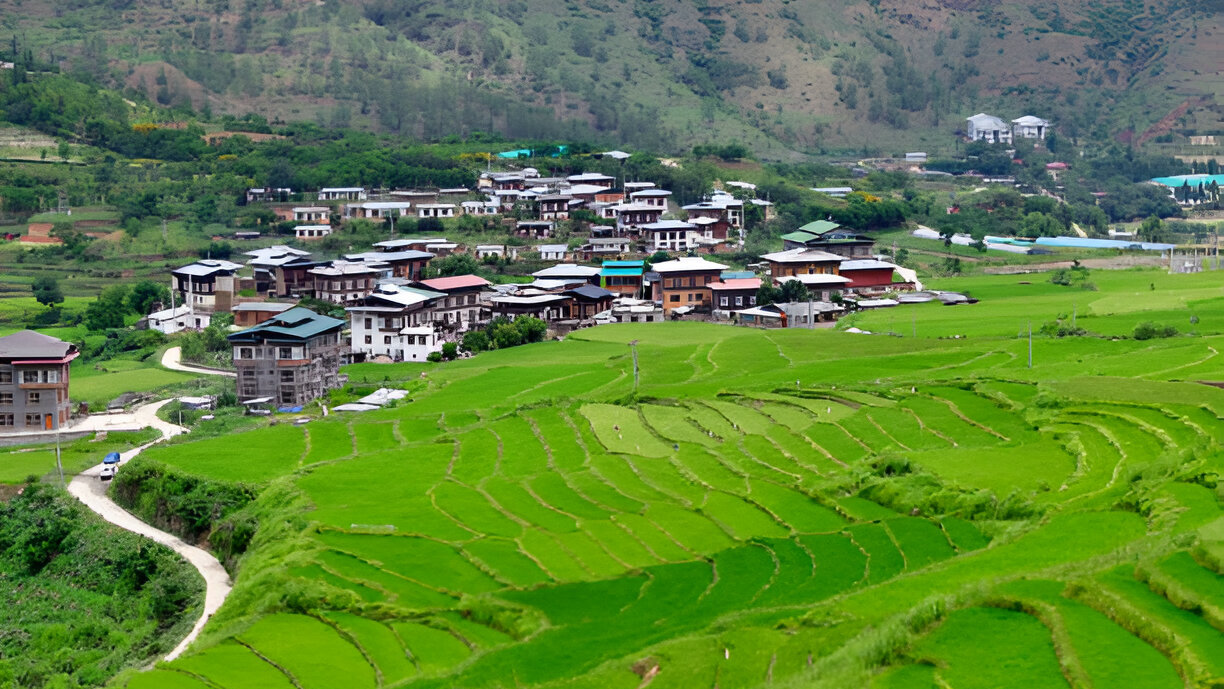
- Peaceful Tradition: Limbukha's residents are known for their historical pledge of peace, famously choosing to carry a white flag instead of a weapon during medieval wars, symbolizing their commitment to peace.
- Red Rice Fields: The village is surrounded by lush paddy fields where the unique red rice is cultivated. This rice variety is not only a staple of their diet but also a significant aspect of their agricultural heritage.
- Scenic Beauty: With its picturesque setting amidst verdant fields and the backdrop of the Himalayas, Limbukha offers stunning landscapes that are perfect for nature walks and photography.
- Traditional Homes: Visitors to Limbukha can explore the traditional Bhutanese homes, known for their sustainable construction and distinctive architectural styles that reflect the region's cultural identity.
- Cultural Insights: The village lifestyle provides insights into the traditional Bhutanese way of life, including their local customs, spiritual practices, and community gatherings.
- Festivals and Celebrations: Limbukha celebrates unique local festivals with traditional music, dance, and communal meals, providing an intimate experience of Bhutanese communal celebrations.
- Hiking Trails: For those who love to explore on foot, the village offers several hiking trails that lead through the rice fields and nearby forests, offering peaceful treks and the chance to encounter local wildlife.
- Community Interaction: Visitors have the opportunity to interact with local families, potentially participating in farming activities or enjoying homemade traditional meals, offering a deep and personal connection to the village and its people.
Limbukha Village is a hidden gem in Punakha, offering more than just scenic beauty; it provides a profound experience of peace and traditional Bhutanese culture. Whether you are interested in agricultural heritage, looking for tranquility, or eager to engage with a community that embodies the spirit of peace, Limbukha is a destination that enriches the soul and offers a calming retreat from the bustling world outside.
Nalanda Buddhist Institute
Situated in the tranquil Punakha valley, the Nalanda Buddhist Institute serves as a revered center for Buddhist learning and monastic education. Known locally as Dalayna, this institute draws its inspiration from the ancient Nalanda University in India, reflecting a deep commitment to preserving and spreading the teachings of Mahayana Buddhism. For visitors and spiritual seekers, the institute offers a unique opportunity to delve into Buddhism's philosophical depths amidst Bhutan's serene landscapes.
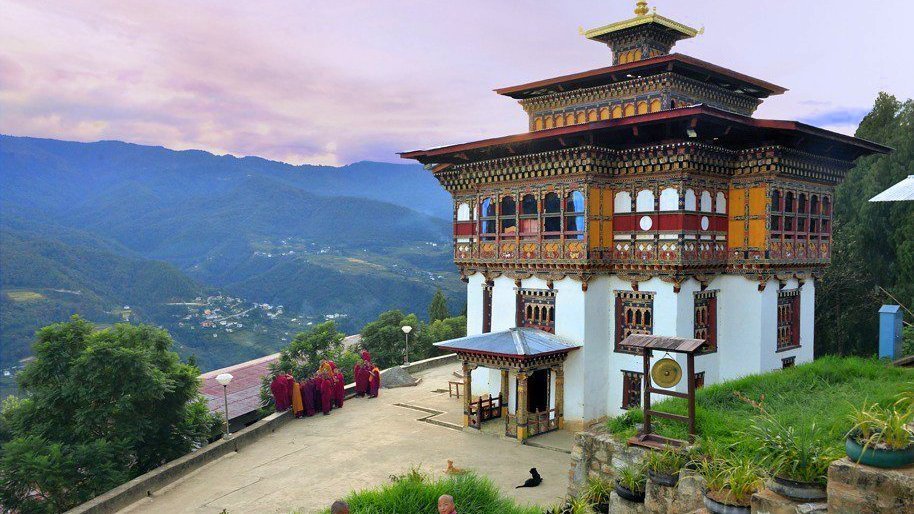
- Center of Learning: As a premier institution for Buddhist studies, the institute educates monks in religious philosophy, rituals, and ancient scriptures, continuing Bhutan's rich tradition of monastic education.
- Architectural Splendor: The campus features traditional Bhutanese architecture, with elaborately decorated buildings that include prayer halls, classrooms, and residential quarters for the monks.
- Spiritual Environment: The institute's location in Punakha, surrounded by lush greenery and distant hills, provides a perfect setting for meditation and spiritual reflection.
- Public Access: Unlike some monastic institutions, Nalanda Buddhist Institute welcomes visitors, offering them a chance to observe monastic life, attend prayer sessions, and interact with monks.
- Cultural Exchange: Visitors can engage in discussions with monks, providing a rare insight into the lives of those who have dedicated themselves to religious study and spiritual practice.
- Historical Significance: The institute upholds the legacy of the ancient Nalanda University, aiming to promote peace and understanding through education and spiritual practice.
- Community Involvement: The institute actively participates in community service and outreach programs, demonstrating the practical application of Buddhist teachings in everyday life.
- Library and Resources: Housing an extensive library of Buddhist texts and scriptures, the institute is a treasure trove of knowledge for researchers and scholars interested in Buddhist studies.
The Nalanda Buddhist Institute is not just an educational institution; it is a spiritual sanctuary that nurtures the mind and soul. Whether you are a student of Buddhism, a researcher, or simply a visitor seeking peace, the institute offers a profound experience that is both enlightening and spiritually enriching. Its commitment to Buddhist education and cultural preservation makes it a pivotal institution in Bhutan's spiritual and cultural landscape.
Ritsha Village
Ritsha Village stands as a charming example of traditional Bhutanese rural life, nestled in the lush landscapes of Punakha. Known for its well-preserved cultural heritage and predominantly agricultural lifestyle, Ritsha is especially famous for its authentic architectural styles and the cultivation of red and white rice. Visitors to Ritsha Village are treated to an intimate view of the daily lives and traditions of its residents, offering a unique cultural experience away from the more tourist-centric locations in Bhutan.
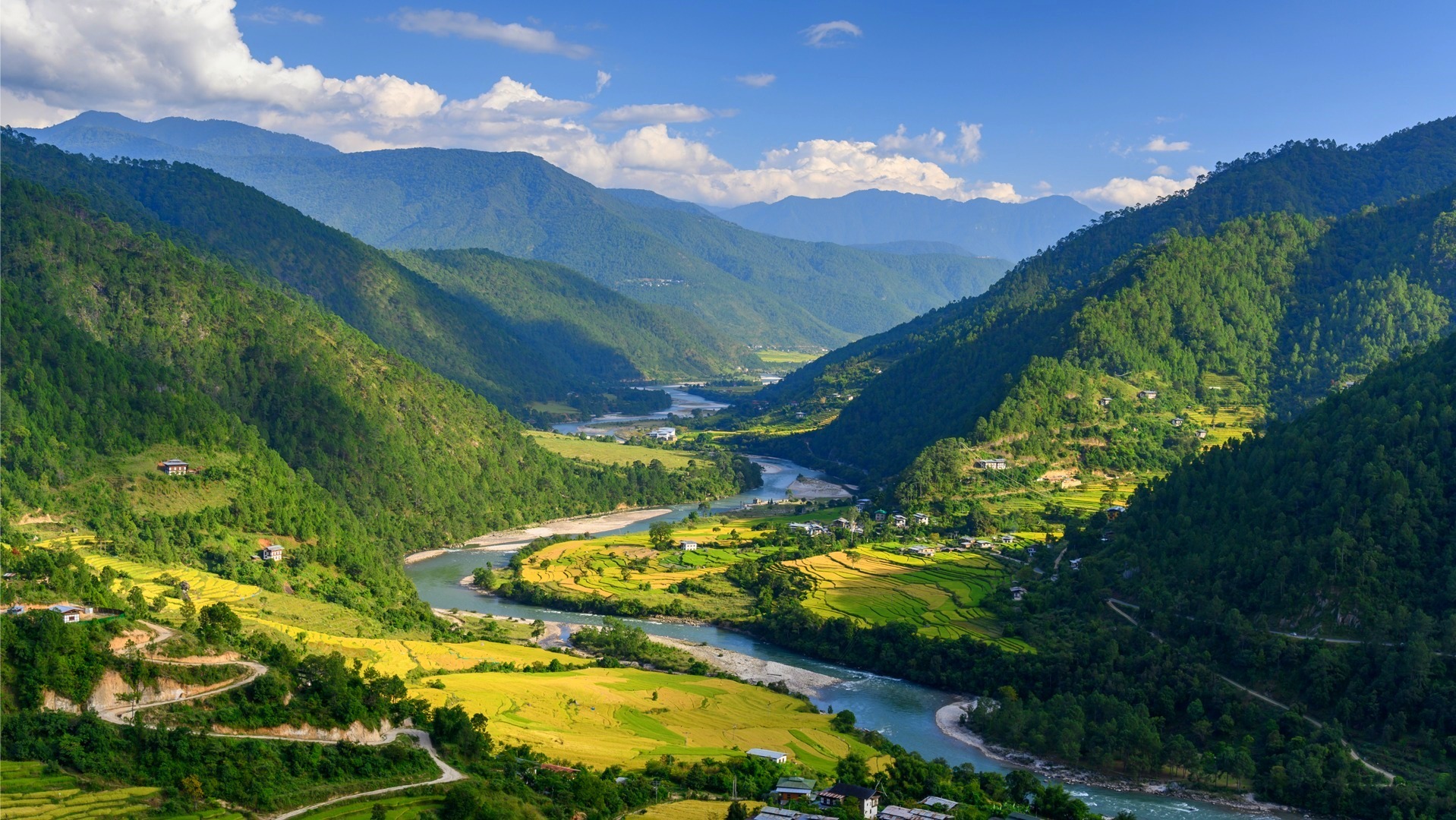
- Traditional Architecture: The village is known for its traditional homes built from pounded mud with stone foundations, which exemplify the classic architectural style of rural Bhutan.
- Agricultural Practices: Ritsha's economy is largely based on agriculture, with the villagers cultivating both red and white rice, which are staple foods in Bhutan and considered delicacies.
- Cultural Preservation: The villagers maintain a strong adherence to their cultural practices, rituals, and traditional Bhutanese ways of life, providing visitors with a living museum experience.
- Community Atmosphere: Ritsha is characterized by its tight-knit community and friendly locals who are often open to sharing their lifestyle with visitors, enhancing the authentic experience.
- Scenic Beauty: Surrounded by paddy fields and the natural beauty of the Punakha valley, the village offers picturesque views and numerous opportunities for photography enthusiasts.
- Local Cuisine: Visitors have the opportunity to taste local dishes made from freshly harvested rice and traditional ingredients, providing a taste of genuine Bhutanese rural cuisine.
- Educational Opportunities: For those interested in sustainable farming and rural development, Ritsha offers insights into traditional farming techniques and the challenges of rural life in Bhutan.
- Festivals and Events: Participating in local festivals or events in Ritsha provides an in-depth look at the cultural significance of these celebrations and their role in community bonding.
Visiting Ritsha Village is an opportunity to step back in time and experience the authentic Bhutanese rural lifestyle. This village not only showcases traditional architecture and agricultural practices but also offers a warm welcome to those who wish to learn about and participate in its cultural traditions. For anyone seeking a deeper understanding of Bhutan beyond its well-trodden tourist paths, Ritsha Village is a compelling and enriching destination.
Sangchhen Dorji Lhuendrup Nunner
Sangchhen Dorji Lhuendrup Nunnery is a serene spiritual haven located in the picturesque landscapes of Punakha. This modern nunnery not only serves as a religious training center for Buddhist nuns but also as a community center for meditation and spiritual learning for visitors from around the world. The nunnery stands out for its stunning architectural design, panoramic views of the valleys, and its commitment to the empowerment and education of Bhutanese women in the spiritual arts.\
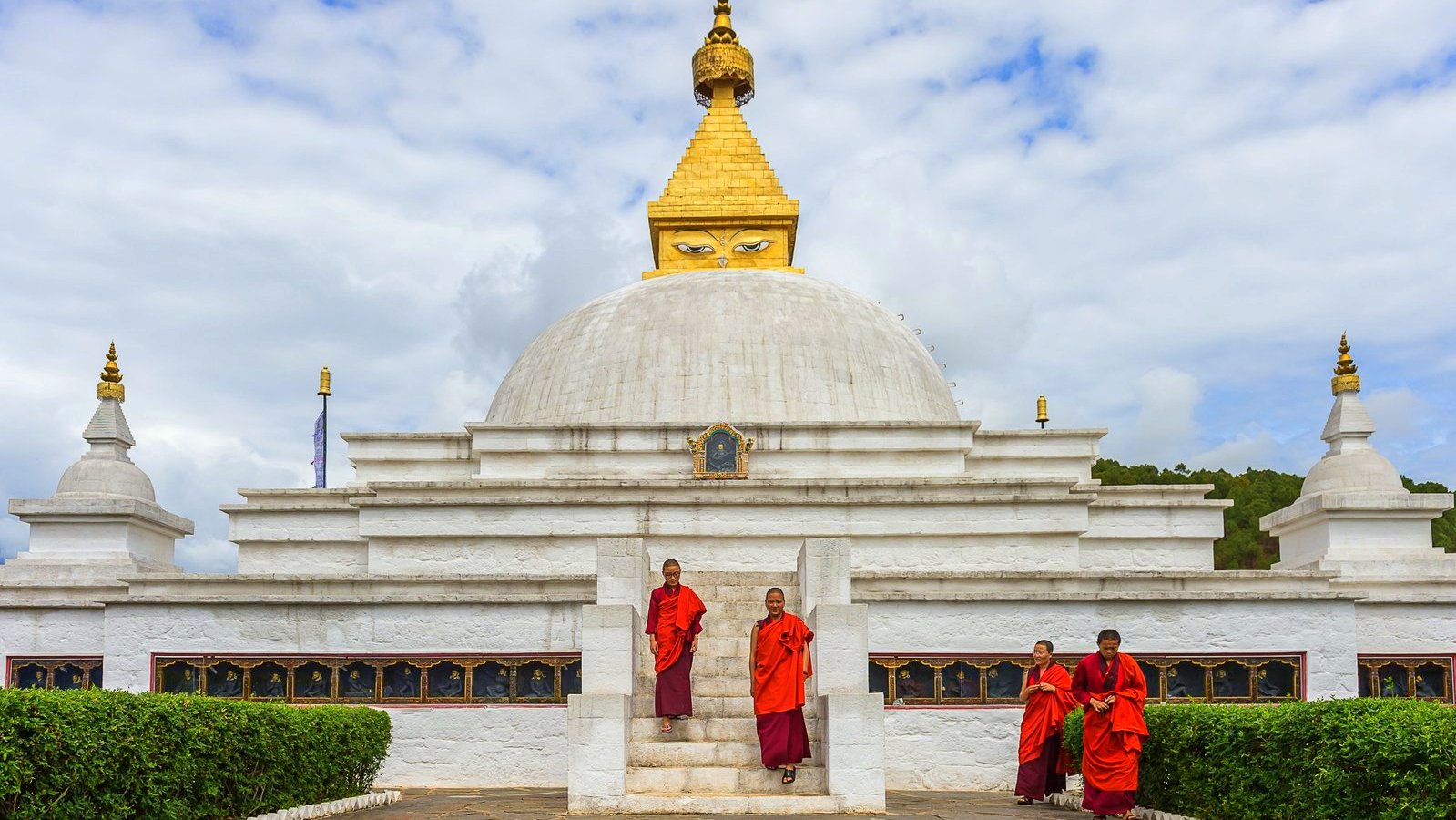
- Spiritual Training Center: The nunnery is dedicated to providing education and spiritual training to Bhutanese women, offering them a path to religious practice and leadership in the Buddhist community.
- Architectural Beauty: Featuring traditional Bhutanese architecture, the nunnery includes intricately carved woodwork, beautiful murals, and a design that complements its tranquil mountain setting.
- Panoramic Views: Located on a hilltop, the nunnery offers breathtaking views of the Punakha and Wangdue valleys, providing a perfect backdrop for meditation and spiritual contemplation.
- Statue of Avalokiteshvara: One of the nunnery’s most revered features is the impressive bronze statue of Avalokiteshvara, the Bodhisattva of Compassion, which symbolizes the virtues of mercy and unconditional care.
- Meditation and Retreat Facilities: The nunnery provides facilities for meditation and spiritual retreats, inviting visitors to engage in personal reflection and spiritual growth in a supportive environment.
- Community Engagement: Sangchhen Dorji Lhuendrup Nunnery actively participates in the local community, with nuns involved in teaching and social work, helping to bridge spiritual practice with community service.
- Art and Craftsmanship: The nunnery also focuses on preserving Bhutanese religious arts by training nuns in sacred painting, sculpture, and embroidery, thus contributing to the cultural heritage of Bhutan.
- Visitor Welcoming: Unlike many monastic institutions, this nunnery is open to visitors, offering them a chance to learn about Buddhist practices, interact with the nuns, and participate in the daily life of the community.
Sangchhen Dorji Lhuendrup Nunnery is more than just a place of worship; it is a vibrant community hub that fosters spiritual, educational, and cultural enrichment. Its stunning location and comprehensive facilities make it a unique destination for those interested in Buddhism, meditation, or simply finding peace away from the bustle of daily life. Whether you are seeking spiritual insight, artistic inspiration, or a peaceful retreat, the nunnery provides an enriching and welcoming environment for all visitors.
Mo Chhu River Rafting
An exhilarating journey down the Mo Chhu River in Punakha, where thrilling rapids and breathtaking natural beauty combine to offer a memorable rafting experience. This popular adventure activity draws thrill-seekers and nature lovers alike to experience the pulsating energy of the river and the serene landscapes of the valley. Perfect for both beginners and experienced rafters, Mo Chhu River rafting provides an exciting yet safe way to explore the unique aquatic landscapes of Bhutan.
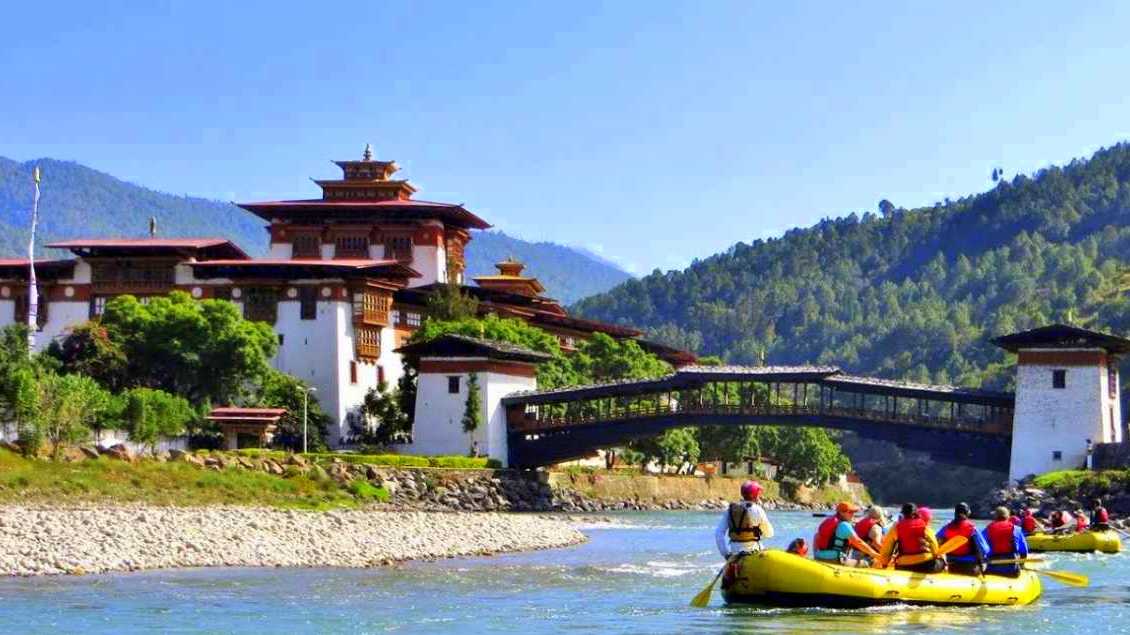
- Thrilling Rapids: The Mo Chhu River features a series of moderate rapids, making it ideal for both novice and seasoned rafters looking for a balance of adventure and scenic tranquility.
- Scenic Beauty: As you navigate the river, you are treated to stunning views of lush forests, verdant valleys, and the majestic Punakha Dzong, offering a picturesque backdrop to your adventure.
- Wildlife Sightings: The riverbanks and surrounding areas are rich in wildlife, including various bird species and occasionally larger animals like mountain goats, providing a delightful experience for nature enthusiasts.
- Cultural Integration: Rafting trips often pass by local villages and historical sites, offering a unique perspective on the cultural heritage of the region from the water.
- Professional Guides: Experienced and knowledgeable guides accompany rafters, ensuring safety while providing interesting insights into the local ecology and history.
- Family-Friendly: The generally mild nature of the Mo Chhu rapids makes this rafting experience suitable for families with children, offering a fun and safe adventure for all ages.
- Accessibility: The river is easily accessible from Punakha, making it a convenient option for a day trip filled with adventure and natural beauty.
- Eco-Friendly Adventure: Rafting on the Mo Chhu is a low-impact way to enjoy the natural environment without harming it, aligning with Bhutan's strong ethos of environmental conservation.
Mo Chhu River rafting offers an unmatched opportunity to combine adventure with the appreciation of nature. Whether you're paddling through mild rapids or simply floating along and soaking in the peaceful ambiance, rafting here promises to be a highlight of any visit to Punakha. It's an exciting, safe, and environmentally friendly way to experience the natural beauty of Bhutan while adding a dash of adrenaline to your journey.
Punakha, with its rich cultural heritage and stunning landscapes, offers a diverse tapestry of experiences for every traveler. From the spiritual serenity of Sangchhen Dorji Lhuendrup Nunnery and the historical majesty of Punakha Dzong to the adrenaline-pumping Mo Chhu River rafting and the peaceful Limbukha Village, this region exemplifies the essence of Bhutan. Whether seeking spiritual enrichment, cultural immersion, or thrilling adventures, Punakha provides a perfect blend of enriching and exhilarating experiences. Each of the Top 10 Places to Visit in Punakha showcases the kingdom's natural beauty and architectural grandeur, enriched by the warmth and hospitality of its people. Join us at Druk Holidays for a journey that promises to be as unforgettable as the landscape itself, where every destination is not just a place to visit, but a profound experience to cherish.
FAQs for the Top 10 places to visit in Punakha
Q: What is the best time to visit Punakha?
A: The ideal time to visit Punakha is during the spring months of March to May when the weather is pleasant, and the flowers are in bloom. Fall, from September to November, is also a great time with clear skies and moderate temperatures.
Q: How can I reach Punakha Dzong?
A: Punakha Dzong can be reached by road from Thimphu, the capital of Bhutan. It's approximately a 2-3 hour drive. The Dzong is located at the confluence of the Pho Chhu and Mo Chhu rivers and is accessible by a short walk from the main road.
Q: Are there any entry fees for the sites in Punakha?
A: Most major attractions in Punakha, such as Punakha Dzong and Sangchhen Dorji Lhuendrup Nunnery, require a small entry fee. These fees are typically included in tour packages if you are visiting with a tour company.
Q: Is rafting on the Mo Chhu River suitable for beginners?
A: Yes, rafting on the Mo Chhu River is suitable for beginners. The river features class I-II rapids, making it a safe and enjoyable experience for first-timers. Professional guides and safety gear are provided by the rafting companies.
Q: Can I visit the Khamsum Yulley Namgyal Chorten on my own?
A: Yes, visitors can hike to Khamsum Yulley Namgyal Chorten independently. The hike typically takes about 1 hour from the nearest road and is a moderate climb. It is recommended to start early to avoid the midday sun.
Q: What are the accommodation options in Punakha?
A: Punakha offers a range of accommodation options from luxury resorts to comfortable guesthouses and homestays, catering to different budgets and preferences.
Q: Are there guided tours available for visiting the top places in Punakha?
A: Yes, there are several guided tours available, which can provide a more informative and structured visiting experience. These tours often include transport, guide services, and entry fees to the attractions.
Q: What should I wear while visiting religious sites in Punakha?
A: When visiting religious sites in Punakha, such as monasteries and dzongs, it is important to dress modestly. This means wearing clothing that covers shoulders and knees. It's also customary to remove your shoes before entering certain areas of these sites.



